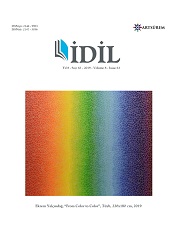Zerdeçal Bitkisinden Doğal ve Kimyasal Mordanlarla Elde Edilen Renkler ve Tekstil Liflerinde Kullanımı
Colors Obtained by Natural and Chemical Mordants from Turmeric (Curcuma Longa) Plant and Usage in Textile Fibers
Author(s): Hülya Kaynar, Emine Tonus, Esra Uçar SözmenSubject(s): Agriculture, Visual Arts, Methodology and research technology
Published by: Sanat ve Dil Araştırmaları Enstitüsü
Keywords: Turmeric; mordant; dyestuff; colour; fastness;
Summary/Abstract: Anatolia has an important geopolitical position which lets many plants have the opportunity to live and involves favourable soils. Plants obtained from these soils have been utilized in all areas of life and one of them is natural dyeing. In order to reduce the negative effects of industrialization on human health, dyes were obtained by using root, stem, leaves and flowers of many plants so various textile products and some foodstuffs were dyed with these dyes. In this study colour changes, friction and water drop (wet-dry) fastness values of turmeric plant which has yellow colour scale were determined using natural and chemical mordants. The plants were boiled during 1 hour by stirring 100% with respect to the wool and hot extracts were prepared. Using seven (7) natural and chemical mordants including Aluminium Potassium Sulphate, Citric Acid, Iron 2 Sulphate, Sodium Carbonate, Vinegar, Hydrochloric Acid and Chimney Soot dyeing was conducted in the range of %3 - 18% with respect to the wool. Moreover, unmordanted ropes were dyed and compared with colour absorption of mordanted ropes.
Journal: İdil Sanat ve Dil Dergisi
- Issue Year: 8/2019
- Issue No: 63
- Page Range: 1579-1589
- Page Count: 11
- Language: Turkish

